
|
Trench Art: Materialities and Memories of War
Hardback
Main Details
| Title |
Trench Art: Materialities and Memories of War
|
| Authors and Contributors |
By (author) Nicholas Saunders
|
| Physical Properties |
| Format:Hardback | | Pages:288 | | Dimensions(mm): Height 234,Width 156 |
|
| Category/Genre | Decorative arts
Man-made objects depicted in art (cityscapes, machines, etc) |
|---|
| ISBN/Barcode |
9781859736036
|
| Classifications | Dewey:745.5088355 |
|---|
| Audience | | Tertiary Education (US: College) | |
|---|
|
Publishing Details |
| Publisher |
Bloomsbury Publishing PLC
|
| Imprint |
Berg Publishers
|
| Publication Date |
1 August 2003 |
| Publication Country |
United Kingdom
|
Description
Trench art is the evocative name given to a dazzling array of objects made from the waste of industrialized war. Each object, whether an engraved shell case, cigarette lighter or a pen made from shrapnel, tells a unique and moving story about its maker. For the first time, this book explores in-depth the history and cultural importance behind these ambiguous art forms. Not only do they symbolize human responses to the atrocities of war, but they also act as mediators between soldiers and civilians, individuals and industrial society, and, most importantly, between the living and the dead. Trench art resonates most obviously with the terror of endless bombardment, night raids, gas attacks and the bestial nature of trench life. It grew in popularity between 1919 and 1939 when the bereaved embarked on battlefield pilgrimages and returned with objects intended to keep alive the memory of loved ones. The term trench art is, however, misleading, as it does not simply refer to materials found in the trenches. It describes a diverse range of objects that have in some way emerged from the experience of war all over the world. Many distinctive objects, for example, were made during conflicts in Bosnia, Vietnam, Northern Ireland and Korea. Surprisingly, trench art predates World War I and it can be made in a number of earlier wars such as the Crimean War, the American Civil War, and the Boer War. Saunders looks at the broader issues of what is meant by trench art, what it was before the trenches and how it fits in with other art movements, as well as the specific materials used in making it. He suggests that it can be seen as a bridge between the nineteenth century certainties and the fragmented industrialized values and ideals of the modern world. This long overdue study offers an original and informative look at one of the most arresting forms of art. Spanning from 1800 to the present day, its analysis of art, human experience, and warfare will pave the way for new research and will be of great interest to cultural and military historians, anthropologists, art historians and collectors.
Author Biography
Nicholas J. Saunders is Lecturer in Material Culture at University College London, and a Senior Research Fellow at the British Academy.
Reviews'Through his most thorough research, the author has almost single-handedly focused the attention of many collectors and curators to the importance of trench art in just the last few years.'James Brazier, Stand To! The Journal Of The Western Front Association"Nicholas J. Saunders is the first person to present this previously disregarded aspect of material culture for academic study. The fruits of his research make compelling reading for anthropologists, historians and curators alike."Paul Cornish, Imperial War Museum 'Saunders has a unique ability to mix anthropology, the study of material culture and of all kinds of traces, and to understand the main questions at the heart of the Great War. He helps us to understand not only the First World War but also the entire scope of violence and suffering in the modern world.' Annette Becker, University Paris-X/Nanterre 'With this work Saunders has achieved one of the holy grails of research: indentifying and developing a subject which has received little if any serious attention from academics ... this is an excellent piece of work and should set the standard for further work in this area from a variety of perspectives.' A.B. Graves, Assemblage
|